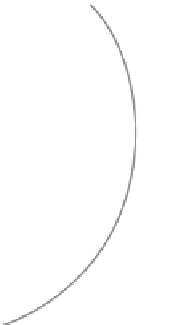Information Technology Reference
In-Depth Information
work with printed documents. Moreover, it enables various forms of collaboration
around paper. Thereby, CoScribe closely combines multiple documents, users and
processes in one integrated environment.
The design of CoScribe was guided by our theoretical interaction model. In the
following, we discuss how the main aspects of this model - the ecological perspec-
tive and modular core interactions - influenced the design.
Ecological Perspective
This holistic socio-technical approach directed our atten-
tion to the various relations that constitute information ecology. These are relations
between multiple users, relations between users on the one hand and documents and
tools they interact with on the other hand, relations between multiple documents,
and relations between users and the practices of a given work setting. We now sum-
marize by which means CoScribe supports each type of relation. These means are
depicted in Fig. 8.1.
Relations between multiple users.
CoScribe puts an emphasis on collaborative
settings. Users can engage in co-located collaboration and remotely share docu-
ments and user-created content. Collaborative content can be accessed in the dig-
ital viewers or printed on paper. To the best of our knowledge, CoScribe is the
first contribution that comprehensively addresses the challenges that are related to
asynchronous sharing of handwritten content on paper. This comprises sharing own
annotations and accessing shared annotations of other users. We presented a mecha-
nism that enables users to share annotations directly on paper, which is is seamlessly
integrated with paper-based annotation. This provides for flexible control of other
persons' access to one's own annotations on various levels of visibility. Evaluation
has shown that it is easy to learn and can be efficiently used after only some minutes
of training. A current limitation is the small amount of feedback available in mo-
Integration of
printed and digital
documents
Unified pen-based
interaction
Ecological view
Cross-media hyperlinks
Tagging of documents
Building blocks for generic
activities
Final design by end-user
User-adaptable printed UI
Tagging of temporal processes
Co-located collaboration
Asynchronous sharing
Paper-
based sharing
Integrated colla-
borative visualization
Fig. 8.1
Mapping of Co-
Scribe's main concepts to the
ecological perspective















































